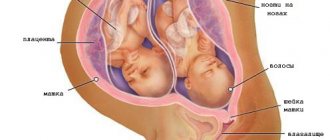Find out the weight of the fetus at 30 weeks of pregnancy, how it is measured and what is considered normal
30 weeks is an important milestone in pregnancy. It is at this time that in obstetric practice it is customary to make another assessment of the health of the fetus and the compliance of its level of development with the generally accepted norm. One of the most important indicators analyzed is the weight of the unborn baby.
How is fetal weight measured during pregnancy?
Measuring the weight of a fetus in the mother's womb is not an easy task. Her decision is fraught with errors in one direction or another. Even all the achievements of scientific and technological progress cannot weigh the future baby with one hundred percent accuracy. Although in most cases, the results of ultrasound (namely, with the help of ultrasound diagnostics, the doctor “weighs” the fetus) are quite accurate.
In addition to automated ultrasound weight calculators, there are ways to determine the baby’s size manually. In this case, the calculations are based on the parameters of a pregnant woman’s abdomen, the size of which is obviously directly related to the fatness of its inhabitant. You will need 2 numbers:
- Fundal height of the uterus (FH): measured with a measuring tape along the midline of the abdomen from the highest point of the uterus (its crown) to the pubic symphysis below. As a rule, the resulting figure will approximately correspond to the gestational age in weeks. That is, a woman with a 30-week pregnancy cannot possibly have a BDSM of 20. A more reliable result in this case will be from 26-27 to 31-32 cm.
- The abdominal circumference (AC) of a pregnant woman is measured at the level of the navel, that is, at the site of the former waist.
The resulting numbers are multiplied and as a result you can find out the approximate weight of the fetus in grams. For example, with an abdominal circumference of 76 cm and a uterine fundus height of 26 cm, the approximate weight of the fetus is 76 x 26 = 1976. The longer the gestational age, the more accurate the result. At 30 weeks, the reliability of the result obtained is 75%.
Important: Much depends on the constitution of the pregnant woman: if the young lady was of impressive size before her interesting position, then the weight of her unborn baby may be less than calculated and vice versa.
Normal fetal weight at 30 weeks of pregnancy
The third trimester of pregnancy is the period of the most active growth of the fetus, when the unborn baby is actively building muscle mass and accumulating the first reserves of subcutaneous fat with which he will be born. It is believed that after 32 weeks of gestation, the child gains weight by 400-500 g every 2 weeks.
At 30 weeks, the fetus usually weighs about 1300-1700 g. Such a large difference in normal weight indicators is due to the fact that there are three gradations at this period:
- lower range – 1300-1400 g;
- average range – 1500-1600 g;
- high range – 1600-1700 g.
Whether the baby's indicators fall into one of the three normal ranges may directly depend on the future mother's nutrition and heredity. After all, if both parents are, as they say, “two inches from the pot,” it is difficult to assume that their future baby is distinguished by high body weight.
Body weight indicators of a 30-week fetus of less than 1300 g and more than 1700 g attract the close attention of an obstetrician-gynecologist. Such situations require a special attitude from the attending physician with clarification of all possible causes of their occurrence.
Important: Fetal body weight cannot be considered in isolation from the dynamics of its increase. If the weight of the unborn child grows evenly, this significantly reduces the risk of suspected pathology of fetal development.
It is traditionally believed that the high weight of a newborn baby is evidence of his excellent health. A similar myth exists about the weight characteristics of the fetus.
For some reason, all expectant mothers want to hear that their child is larger than usual. These words inspire them with strong confidence that everything is fine with the baby.
In fact, the reasons for high weight can be both physiological and pathological:
- The hereditary basis lies in the phenotypic characteristics of the parents. Scientists have found that in most cases a child inherits height from the father's side, but weight from the mother's side. So if the expectant mother is prone to obesity, then the fetus she is carrying will most likely weigh more than usual.
- Maternal endocrine diseases. Diabetes mellitus, obesity and some thyroid diseases provoke a pathological increase in fetal weight. In some cases, this increases the risk of similar diseases in the child.
- Hemolytic disease is an incompatibility of the blood of mother and fetus according to the Rh factor, which in severe cases (not always!) can lead to the formation of edema in the unborn child, which in turn affects its metric parameters.
- Poor nutrition with a predominance of fats and carbohydrates in the diet of a pregnant woman is the most common cause of fetal hypertrophy.
- Incorrect determination of the gestational age - if the actual gestational age exceeds the one the doctor is guided by.
- Not my first pregnancy. Typically, first-born children are born weighing less than their younger siblings.
- Excessive consumption of vitamin and mineral complexes for pregnant women. According to unconfirmed reports, the use of certain vitamins during gestation leads to the birth of large children.
Important: A large fetus is not a problem if there are no pathological reasons for it. But in any case, a pregnant woman should review her diet and reduce its calorie content. After all, giving birth to a large child is much more difficult, and the risk of birth injuries and postpartum complications increases.
Fetal weight deficiency: causes and consequences
A condition in which the fetal weight at 30 weeks is reduced compared to normal levels is diagnosed as “fetal hypotrophy” and requires medical intervention. After all, such a lag in weight may indicate:
- about intrauterine growth retardation caused by a lack of oxygen and nutrients;
- about fading pregnancy;
- about serious pathologies in the health of the unborn child.
The following causes of weight loss in the fetus are identified:
- Maternal health disorders. If the expectant mother has serious infectious diseases, anemia, late toxicosis or anorexia, this can cause dystrophy in her unborn child.
- Unfavorable environmental conditions and unhealthy lifestyle of a pregnant woman. Nicotine-dependent mothers risk being diagnosed with “fetal hypotrophy” during pregnancy many times more than their non-smoking counterparts. Alcohol and drug addicted women threaten not just their health, but also the life of their unborn child.
- Fetoplacental insufficiency. Rapid aging, placenta previa or abruption, its failure as a life-support organ for the child can lead to a deterioration in the blood supply to the fetus, the development of hypoxia and developmental delays.
- Umbilical cord entanglement can also cause fetal hypoxia and, as a result, a deficiency in its weight.
What to do if the fetal weight at 30 weeks of pregnancy is not normal
Most often, this question is asked by mothers who have been diagnosed with a low-weight fetus. In this case, you need to follow the following algorithm of actions:
- Do not panic and do not fall into hysterics - the negative emotional state of the mother will boomerang on the health of her child.
- Find out what degree of malnutrition is diagnosed in the baby. Most often we are talking about 1st degree of malnutrition, which is the mildest and does not threaten the life and health of the child if detected in a timely manner.
- Be sure to find out all the possible causes of weight loss in the fetus.
- Follow all medical recommendations and carefully monitor the baby’s condition. It is necessary to monitor the child’s motor activity throughout the day. A sharp decrease in the number of movements is an alarming signal that requires immediate consultation with a doctor.
- Diversify your diet and include more high-calorie foods in your diet.
- Monitor the child’s condition using ultrasound over time: several weeks after diagnosis and then on the recommendation of the attending physician.
When you can't do without hospital treatment
In some cases, it is simply impossible to do without treatment in a hospital facility. A pregnant woman should not neglect the doctor’s recommendation to go to a hospital: after all, there she will be under constant supervision and, if something happens, she and her child will be able to receive timely and qualified assistance.
If fetal malnutrition is diagnosed, treatment includes:
- protective regime and normalization of nutrition;
- conducting cardiotocographic and Doppler studies;
- eliminating the cause of intrauterine growth retardation: prescribing medications that improve capillary blood flow and blood supply to tissues;
- prescription of antihypoxants and antispasmodics: to treat the consequences of a malfunction in the child-bearing system.
Treatment lasts at least 1-2 weeks, after which a control ultrasound is performed.
Information about the weight of the fetus at 30 weeks is very important in order to draw a conclusion about the compliance of the child’s development with standard indicators.
But even if the baby’s weight does not fit into standard norms, there is no need to panic. Perhaps everything is not as critical as it might seem at first glance.
A competent doctor will be able to help both the expectant mother and her unborn baby - you just need to be able to listen and hear the doctor.
- Administrator
Source: https://moy-kroha.info/ves-ploda-na-30-nedele-beremennosti
What do fetal movements indicate?
Movement is life. And even in the uterine period. You've already monitored your little one with an ultrasound, haven't you? This is a little man with arms, legs, a heart... In a bad and good mood, in a comfortable, or not so comfortable, position. So how can he tell you about all this? Naturally - with pushes.
A very common occurrence is baby hiccups. Experts say that it does not pose any danger to the baby and does not cause him any discomfort. But mommy will feel it in the form of rhythmic tremors inside herself. Such episodes can occur up to several times a day.
Remember the pregnancy calendar by week. This will also help you understand why your baby is moving. It often requires your attention as early as 21 weeks. Recognizing your voice, dad's voice, distinguishing loud sounds and gentle melody, reacting to light, he will naturally let you know about his feelings and preferences. Undoubtedly, many already accomplished mothers return with nostalgia to their “pregnant” days. We remember very well how the little one calmed down in the womb if the mother was upset or angry... And how carefully he reminded himself when the storm of emotions subsided... And who doesn’t remember the “dancing” nights! Barely dragging her feet to the bed, the expectant mother plunges into long-awaited relaxation, and... no such luck! The period of wakefulness begins in the stomach! The baby still lives according to his own schedule and is not going to take your adjustments into account.
A baby can perform up to 500 different movements per day. Naturally, you won't hear everything. After all, the perceptibility of movements depends on many factors: the amount of intrauterine fluid, the thickness of the abdominal wall, the position of the baby and placenta, the baby’s mobility, the sensitivity of the mother.
Starting from the 32nd week of pregnancy, the position of the fetus in the uterine cavity can be determined by the baby’s movements. If he is in a breech position, you will feel the tremors in the lower abdomen. And if the toddler “stomps” above the navel, it means the presentation is cephalic. Towards the end of pregnancy, the baby is also preparing to be born. His movements are already more rare, but by no means absent.
The absence of any movement for more than 12 hours is a serious reason to consult a doctor.
In addition, you will need to consult a gynecologist if the child’s movements are too rare, sluggish or, conversely, violent and painful. In any case, this indicates the suffering of the fetus. Most often, this condition is caused by hypoxia - oxygen starvation. But experts disagree on how to distinguish this pathology. Some believe that with hypoxia the fetus becomes too violent, while others believe that it is the opposite. However, regardless of how your baby lets you know that he doesn’t have enough oxygen, take his signals into account. After all, hypoxia often causes fetal death. The causes of hypoxia are very different: diabetes, anemia, cardiovascular diseases, fetal disease and much more. Only a doctor can confirm or refute such a diagnosis. To do this, an ultrasound examination is usually performed, heart sounds are listened to, and a CTG is also performed.
Cardiotocography is a very informative method for assessing the condition of the fetus. During this examination, the baby's heartbeat is recorded for 1 hour. The norm is not a monotonous, but a variable heart rate, which ranges from 120 to 160 beats per minute. With severe fetal hypoxia, the heart rate is up to 90 beats per minute. In this case, an immediate caesarean section is performed if the pregnancy is more than 30 weeks.
Many doctors recommend that pregnant women do fetal movement tests themselves. A widely used test is D. Pearson: “Count to ten.” It should be carried out from the 28th week of pregnancy. From 9 a.m. to 9 p.m., movements are counted. The time of the 10th movement is recorded daily on a special card. If your baby is inactive, consult your doctor.
Typically, violent or weak movements can be “coaxed” and “trained.” It is believed that the baby reacts sharply to the mother’s uncomfortable position. Especially recumbent. And as soon as she turns over, the child calms down.
If, on the contrary, you need to motivate your little one, they recommend eating something sweet. After all, carbohydrates enter the bloodstream first and very quickly. The baby gets a portion of dessert and this makes him cheer up.
Still, your main task remains to maintain a good mood. Under no circumstances should you make panicky calculations of every rollover and thrust. Enjoy communication with your little angel. Pay him as much attention as possible, take care of your health, watch your diet and daily routine. Have family get-togethers. The baby will be happy to listen to a fairy tale from dad, a lullaby from mom. Let the movement of your future baby bring only joy. After all, this state is fleeting and nothing can return it to you. Don't miss the most touching moment of your life!
Condition of mother and child at 30 weeks of pregnancy
The 30th week of pregnancy is an active time. It's time to take tests to apply for maternity leave. The most difficult trimester of pregnancy begins, requiring calm and patience from the mother.
Pain
Often at 30 weeks women are bothered by lower back pain. This is quite natural. The uterus has grown, the abdomen has increased and the center of gravity has shifted. Gymnastics will help relieve stress from the spine.
A woman does not need to panic about every pain that occurs in the body. But you definitely need to know which of them are considered a problem.
Sometimes pain is associated with poor diet. Avoid foods that cause bloating and gas. Pain on the sides of the abdomen can occur due to spraining of the ligaments that support the abdomen. It will become easier if you lie on your side with your legs bent.
Headaches at 30 weeks are also not uncommon. There is no need to endure this pain, and it is not advisable to take painkillers. Try to be outdoors often, not to overwork, and to rest.
If the pain does not go away, apply a fresh cabbage leaf to your head, wrap it in a scarf and just lie in a dark room. A light head massage will help.
If you experience unusual pain in the lower abdomen, consult your doctor.
Nature of the discharge
At 30 weeks of pregnancy, the nature of the discharge may change. Normally, there is a homogeneous discharge of a whitish tint without an unpleasant odor. At the same time, their quantity increases, and their consistency becomes more liquid.
If yellow or green discharge appears, this may indicate a bacterial infection. White curdled discharge accompanied by a burning sensation is thrush.
Pink or brown spotting may appear. All deviations from the norm require consultation with a doctor. Bloody discharge may indicate problems with the cervix and placenta.
There is a possible risk of premature birth.
Watery discharge without color or odor may be a sign of leakage of amniotic fluid. Sometimes coughing or sneezing is accompanied by a slight leak of urine. This is a fairly common occurrence in the third trimester and is considered normal.
All discharge mixed with blood is dangerous.
Uterine growth
The uterus has grown significantly and feels very good. The height of the fundus of the uterus is approximately 28-31 cm. During this period, the uterus grows a little slower, and by childbirth its height will decrease slightly. This will happen due to the baby taking the correct position. Its head will descend towards the pelvic outlet.
At week 30, the uterus rises almost 10 cm above the navel line. The abdomen is located directly under the breast. This somewhat limits mobility and causes shortness of breath. The pressure of the uterus on the diaphragm causes a feeling of constant lack of air.
The internal organs are now working in a compressed state. The stomach has difficulty digesting. Stomach juice may be released into the esophagus, causing the pregnant woman to experience heartburn. Pressure on the gallbladder leads to indigestion. Belching, nausea, or loose stools may occur.
Frequent visits to the toilet indicate that the bladder is also working under extreme conditions. At week 30, the cervix normally decreases to 30-35 mm. If the cervix becomes shorter, there is a risk of premature birth. It may not support the weight of the fetus and open prematurely.
Weight gain
The rapid weight gain that began at week 29 continues. Normally, pregnant women gain about 11 kg by week 30. The body is preparing for childbirth. Amniotic fluid accumulates. Total weight gain should not exceed 18 kg. Excess weight can lead to complications during childbirth.
Training contractions
Pregnancy is 30 weeks - the development of the fetus is still ongoing, and the feelings of the expectant mother are also changing. The first contractions appear already at 20 weeks. But this does not mean that labor has occurred.
Many women simply do not notice the first preliminary contractions. Few pregnant women note them as tension in the abdomen, possibly a painful sensation. There is no need to worry about this.
Contractions in this case are harmless.
Closer to childbirth, their intensity increases, and the intervals between them become shorter. A uterine spasm is possible when it contracts for quite a long time. The uterine os does not open, since the cramp of the uterus is accompanied by a cramp of the external uterine os, which does not allow it to open.
Not everyone experiences training contractions. This is fine.
Other changes
Sometimes a woman develops pigmentation on her skin before the 30th week. At this time and later, new spots will no longer appear, but old ones will begin to disappear only after childbirth. Many people experience increased dry skin during this period. This is due to physiological reasons. Review your diet and include foods rich in vitamins A and E.
During this period, the heart and blood vessels work with increased load, the amount of blood has increased by almost half. This causes rapid heartbeat, flushing of the face, and slight blurred vision.
Many women at this time complain of problems with sleep and falling asleep. Lying on your back is no longer possible. The only resting position is on your side. Frequent changes in position constantly wake up a woman. Due to constant lack of sleep during the day, drowsiness and irritability are possible.
Fetal movements
The 30th week of pregnancy has arrived, what happens to the baby? He is quite active. But there is less and less room for movement. The baby is already stronger, and you can clearly see what position he is in. His movements are clearly felt. Mom already knows the reasons for the decrease in activity or its increase.
The movements become a little less. The baby no longer has enough space. But the strength of the movements is growing, the tremors are felt very clearly. The child already has his own daily routine. He sleeps, plays, communicates.
With his movements, he can remind his mother that it is time to eat, or that he is bored. Mom's joy is accompanied by the production of serotonin. The baby receives the hormone through the blood, and its activity also increases.
At night, all children become more active, and this is normal.
Many people try to touch the belly and feel the baby's movements. Don't allow it if it's unpleasant.
How to count movements?
To make sure that the fetus is developing normally and to know that it is not in danger, you need to count the movements.
There are several ways to measure your baby's movements:
- Measure for an hour: during maximum activity, count all movements. Normally there should be at least 6 of them;
- measurement for 6 hours: at any time of the day, at least 10 active movements are determined;
- 12-hour measurement: movements are recorded for 12 hours, usually at least 24.
30th week of pregnancy - fetal development
The baby continues to grow and at 30 weeks of pregnancy he looks almost like a newborn. The babies are about 40 cm tall and weigh 1500 g. Girls are slightly smaller than boys. Usually 200-300 grams.
Appearance
30th week of pregnancy - what happens to the baby, what does he look like? The baby's skin color changes from bright red to pink. The skin becomes thicker and stronger.
Blood vessels are no longer visible through the epidermis. From this time on, pigments begin to be produced. Therefore, the hair on the child’s head begins to darken.
Light-skinned babies remain that way, but the skin of dark-skinned children darkens.
The baby's eyelashes are growing. The ears still stick out a little, but after a month the cartilage tissue will harden and they will stop sticking out so much. The body becomes more proportional. Subcutaneous fat increases. The tummy, legs and arms get better, plump cheeks appear. The baby already knows how to smile, yawn, clench his fists, and suck his fingers.
Nervous system development
The most global changes occur in the child’s nervous system. Development happens constantly. During this period, the process of differentiation of the cerebral cortex is completed. The foundations have already been laid, but the convolutions and furrows are still being formed. Every day new neural connections emerge.
The brain takes control of the organs and systems of the body. Several dozen reflexes appear - motor, sucking, breathing and others. Babies have good hearing. Visual receptors already distinguish between light and darkness. A blink reflex has formed. The child opens and closes his eyes.
Internal organs
The completion of the formation of internal organs occurred during the period of embryonic development. The organs are now growing. The heart has grown quite noticeably; it is already beating at a frequency of 140-160 beats per minute.
The kidneys are actively working and produce up to 0.5 liters of urine per day. The bladder is emptied once an hour. Bile production has already been established, insulin is being produced.
The intestines can already contract and make movements reminiscent of full peristalsis.
Lung tissue is still developing. The alveoli are almost formed. At this time, a very important substance accumulates - surfactant. The baby’s life depends on its sufficient quantity.
The first inhalation and exhalation fill the lungs with oxygen and remove carbon dioxide. But in order for the second breath to take place and the alveoli not to stick together, a surfactant is needed.
Its deficiency can cause respiratory failure and death.
Baby on ultrasound
An ultrasound at 30 weeks of pregnancy is not usually prescribed. A routine ultrasound examination is scheduled at 32 weeks. Often expectant mothers undergo the procedure on their own initiative. At this time, the first photos of the child appear. Recommendations for diagnosis may also be medical recommendations. The reason may be monitoring the development and condition of the child:
- disturbances in fetal motor activity;
- suspected developmental delay;
- clarification of the timing of pregnancy before a woman goes on vacation;
- control of the development of twins, triplets;
- pregnancy control through IVF;
- Fetal fetometry is performed;
- the presentation and degree of maturity of the placenta is determined;
- At this stage, the doctor already has a good look at the internal organs and will be able to notice deviations in development or pathology.
Dangers and Risks
Premature birth at this stage is the greatest danger. The baby is not yet ready to be born. To reduce the risk, you need to avoid physical activity, stress, and lifting heavy objects.
At 30 weeks of pregnancy, immunity is reduced. Possible infection with infectious diseases. Now infections do not pose a great danger to the fetus. It is protected by its own immunity and the placenta. The danger is not the disease, but self-medication. Any treatment is prescribed only by a doctor.
Analyzes and examinations
To apply for maternity leave this week, the following tests are taken:
- general urine test to determine the presence of gestosis (complications);
- a general blood test shows the presence of anemia;
- blood chemistry;
- blood for HIV, syphilis, hepatitis;
- CTG (fetal heart rate);
- hormone analysis.
Premature birth at 30 weeks of pregnancy
At 30 weeks, the fetus has not yet developed to the required level of independent functioning. His life will be maintained artificially with the help of devices.
The child is born prematurely with a very low body weight - up to 1.5 kg. The lungs are still immature. However, doctors achieve their accelerated maturation with the help of steroid hormones.
It is very difficult to predict preterm birth because there are no symptoms.
Clinical picture of premature birth:
- increased tone of the uterus, nagging pain in the lower back, cramping pain in the lower abdomen;
- feeling of fullness in the vaginal area;
- frequent urination.
The method of delivery depends on the condition of the mother and fetus.
The main cause of premature birth is rupture of amniotic fluid. In this case, labor begins quickly. At risk are women who are very young or over 35 years of age. The cause may be a disease or pathology, both systemic and infectious.
Caring for premature babies is quite difficult. But all organs are already formed, and perinatal centers are well equipped; the survival rate of such children is 100%.
Diet
Meals at 30 weeks of pregnancy should be fractional.
- You need to eat often and in small portions.
- For snacks, fruit or yogurt are suitable.
- Introduce fiber into your diet to normalize digestion.
- Eat fresh greens.
- The diet should include lean meat, fish, eggs and dairy products.
- To prevent anemia, liver, buckwheat, tomatoes, raisins and dried apricots are useful.
Prohibited foods include smoked meats, pickles, carbonated drinks, products with preservatives and dyes, canned food, chocolate and sweet pastries.
Vitamins
Prenatal multivitamins contain many synthetic vitamins and minerals. They must restore balance in a woman’s body and compensate for their deficiency. It is not always necessary to take such drugs.
Women who fall into these categories can take vitamins:
- Pregnant women who lack adequate nutrition.
- Women who have had diseases associated with vitamin deficiency.
- Pregnant women whose previous pregnancy ended in termination.
- Pregnant women over 30 years of age.
Not all women need to take vitamin supplements. You should not make an appointment for yourself. It is better to consult a doctor.
Sex at 30 weeks pregnant
Sexual intercourse can change the position of the fetus. However, if the pregnancy is progressing normally, then this is quite acceptable. At the 30th week of pregnancy, the belly is already large and partners should avoid positions that could compress it.
What determines the mobility of a child in the womb?
Many people believe that a baby’s character is formed in the tummy. Here's your answer: a toddler who is too active will make itself known right away. Although this is not always the case. Often, a baby’s movements are evidence not of his temperament, but of his well-being, development and health. Therefore, the task for a pregnant woman is very important: to analyze every step of her little one, learn to understand and feel it. Any deviations from your normal life together should be recorded.
Normal movements during pregnancy
There are no clear “normal” indicators. Although it is generally accepted that, starting from the 25th week of pregnancy, the baby should move at least 10 times per hour.
Causes of pain
Pain, in the literal sense of the word, should not bother a woman at 26 weeks of pregnancy. However, due to her condition, she may experience some discomfort.
Painful sensations may be due to the following reasons:
- Abdominal pain may be associated with active movements of the child. Firstly, he has less and less space left in the uterus. Secondly, the fetal muscle strength continues to increase.
- Pain in the lower abdomen, in the sacrum and pubic area is associated with the fact that the enlarged uterus puts pressure on the internal organs. In addition, against the background of the preparatory process for the upcoming birth, softening of the joints and ligaments occurs.
- Pain in the legs and lower back occurs due to increased stress on them. To relieve discomfort, you need to rest more, taking the correct posture. You should also avoid wearing high-heeled shoes. When resting, you need to place a small cushion or pillow under your feet.
- You can eliminate headaches by taking a short nap during the day in a cool and well-ventilated room.
General tips to help a woman minimize discomfort: more movement, but without heavy physical activity, adequate rest, fresh air and proper nutrition.
What's happening to the stomach?
The belly is now quite noticeable, it protrudes even from under loose clothing. The 26th week of pregnancy is the time to start actively caring for the skin of your abdomen and chest to prevent the appearance of stretch marks. If you don’t do this now, getting rid of stretch marks in the future will be very problematic. To prevent stretch marks, you can use moisturizing creams and gels, or olive oil. You need to rub the selected product not only into the skin of the abdomen, but also into the skin of the chest and thighs.
An enlarged belly can cause a woman to lack sleep, as it will become increasingly difficult for her to find the optimal position for night rest. Doctors agree that the most physiological position for sleeping now is to lie on your side with your knees bent. To reduce the load on your back and spine, you can cover yourself with pillows.
What happens to the uterus?
The uterus reaches a height of 24 cm and a width of 16 cm. It is located 6 cm above the navel and 26 cm above the pubis. It is worth understanding that these numbers will continue to increase. On average, the uterus rises 1 cm above the navel every week.
The cervix gradually fills with mucus, which has a thick and viscous consistency. This is the so-called mucus plug, which will come off a few weeks before labor or just before it begins.
At 26 weeks of pregnancy, the uterus may begin to contract slightly and almost painlessly. In this way she prepares for the upcoming birth. Doctors call these contractions Braxton-Higgs contractions or training contractions.
If suddenly a woman begins to experience abdominal pain, which constantly intensifies, and is also accompanied by the appearance of discharge (heavy or spotting, with or without blood), then it is necessary to urgently call an ambulance. Perhaps this is premature birth.









